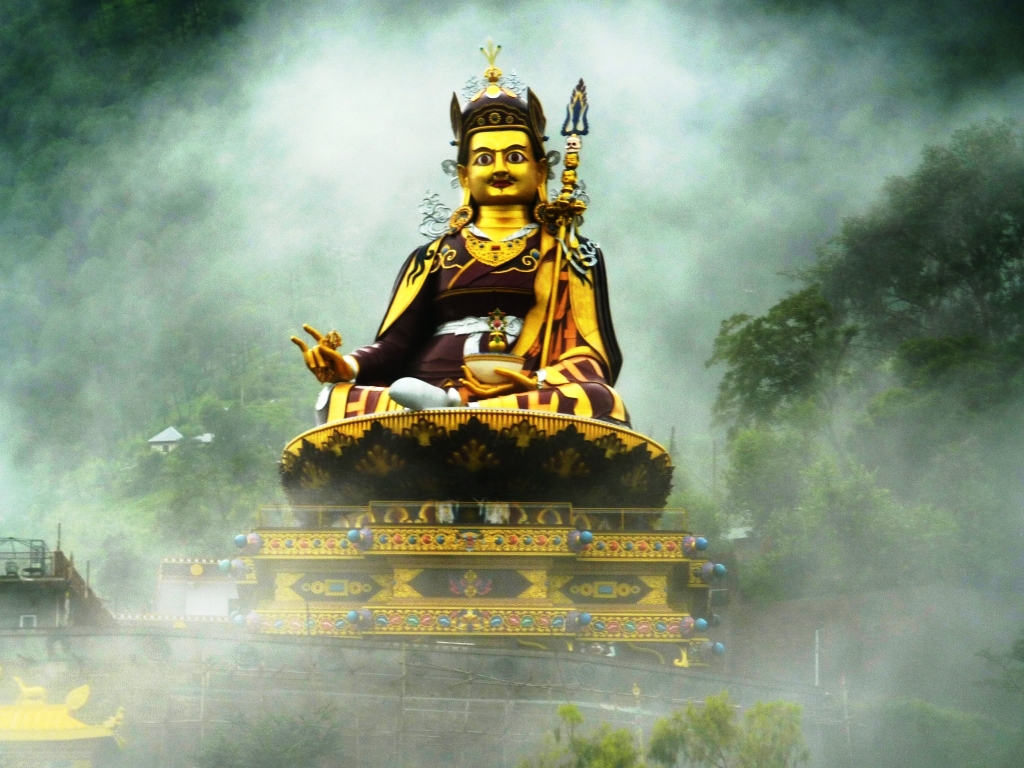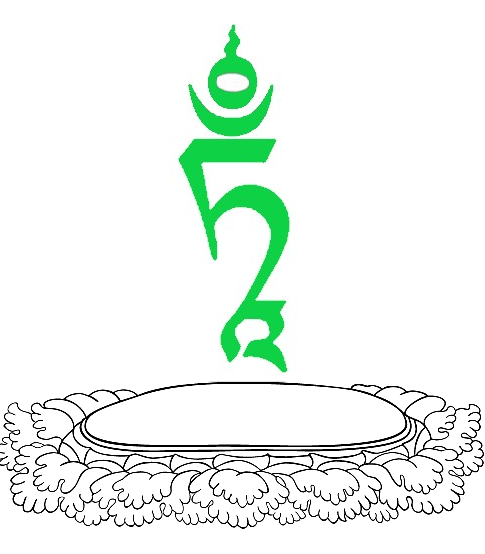|
Ngöndro
In Tibetan Buddhism, Ngöndro (, ) refers to the preliminary, preparatory or foundational practices or disciplines (Sanskrit: sādhanā) common to all four schools of Tibetan Buddhism and also to Bon. They precede deity yoga. The preliminary practices establish the foundation for the more advanced and esoteric Vajrayana sādhanā which are held to engender realization and the embodiment of Dzogchen, Heruka and Mahamudra. Nevertheless, Vajrayana masters are careful to point out that "foundational" does not mean "lesser," that the practice of Ngöndro is a complete and sufficient practice of the spiritual path, and that it can take the practitioner all the way to full enlightenment. In addition to what is generally denoted by the term ''ngöndro'', preparatory practices may also be prescribed for senior and advanced sadhana, e.g.: "differentiating saṃsāra and nirvāṇa" () is the preparatory practice for trekchö or "cutting through to primordial purity." Outer and inner ... [...More Info...] [...Related Items...] OR: [Wikipedia] [Google] [Baidu] |
Tibetan Buddhism
Tibetan Buddhism is a form of Buddhism practiced in Tibet, Bhutan and Mongolia. It also has a sizable number of adherents in the areas surrounding the Himalayas, including the Indian regions of Ladakh, Gorkhaland Territorial Administration, Darjeeling, Sikkim, and Arunachal Pradesh, as well as in Nepal. Smaller groups of practitioners can be found in Central Asia, some regions of China such as Northeast China, Xinjiang, Inner Mongolia and some regions of Russia, such as Tuva, Buryatia, and Kalmykia. Tibetan Buddhism evolved as a form of Mahayana, Mahāyāna Buddhism stemming from the latest stages of Indian Buddhism (which included many Vajrayana, Vajrayāna elements). It thus preserves many Indian Buddhist Tantra, tantric practices of the Gupta Empire, post-Gupta Medieval India, early medieval period (500–1200 CE), along with numerous native Tibetan developments. In the pre-modern era, Tibetan Buddhism spread outside of Tibet primarily due to the influence of the Mongol Emp ... [...More Info...] [...Related Items...] OR: [Wikipedia] [Google] [Baidu] |
Padmasambhava
Padmasambhava ('Born from a Lotus'), also known as Guru Rinpoche ('Precious Guru'), was a legendary tantric Buddhist Vajracharya, Vajra master from Oddiyana. who fully revealed the Vajrayana in Tibet, circa 8th – 9th centuries... He is considered an emanation or Nirmāṇakāya of Gautama Buddha, Shakyamuni Buddha as foretold by the Buddha himself. According to early Tibetan sources including the ''Testament of Ba'', he came to Tibet in the 8th century and designed Samye Monastery, the first Buddhist monastery in Tibet during the reign of King Trisong Detsen. He, the king, and Khenpo Shantarakshita are also responsible for creating the Tibetan canon, Tibetan Canon through translating all of the Buddha's teachings and their commentaries into the Tibetan language. According to Lewis Doney, while his historical authenticity was questioned by earlier Tibetology, Tibetologists, it is now "cautiously accepted.” Padmasambhava himself was recorded as saying he was an historical per ... [...More Info...] [...Related Items...] OR: [Wikipedia] [Google] [Baidu] |
Dzogchen
Dzogchen ( 'Great Completion' or 'Great Perfection'), also known as ''atiyoga'' ( utmost yoga), is a tradition of teachings in Indo-Tibetan Buddhism and Bön aimed at discovering and continuing in the ultimate ground of existence. The goal of Dzogchen is the direct experience of this basis, called (Sanskrit: ). There are spiritual practices taught in various Dzogchen systems for discovering . Dzogchen emerged during the first dissemination of Buddhism in Tibet, around the 7th to 9th centuries CE. While it is considered a Tibetan development by some scholars, it draws upon key ideas from Indian sources. The earliest Dzogchen texts appeared in the 9th century, attributed to Indian masters. These texts, known as the Eighteen Great Scriptures, form the "Mind Series" and are attributed to figures like Śrī Siṅgha and Vimalamitra. Early Dzogchen was marked by a departure from normative Vajrayāna practices, focusing instead on simple calming contemplations leading to a di ... [...More Info...] [...Related Items...] OR: [Wikipedia] [Google] [Baidu] |
Prostration (Buddhism)
A prostration (, , zh, c=禮拜, , ) is a gesture used in Buddhist practice to show reverence to the Triple Gem (comprising the Buddha, his teachings, and the spiritual community) and other objects of veneration. Among Buddhists prostration is believed to be beneficial for practitioners for several reasons, including: *an experience of giving or veneration *an act to purify defilements, especially conceit *a preparatory act for meditation *an act that accumulates merit (see karma) In contemporary Western Buddhism, some teachers use prostrations as a practice unto itself, while other teachers relegate prostrations to customary liturgical ritual, ancillary to meditation. Theravada Buddhism In the Pali canon, laypersons prostrating before the then-living Buddha is mentioned in several suttas. In Theravada Buddhism, as part of daily practice, one typically prostrates before and after chanting and meditation. On these occasions, one typically prostrates three times: once to the ... [...More Info...] [...Related Items...] OR: [Wikipedia] [Google] [Baidu] |
Bodhicitta
In Mahayana Buddhism, bodhicitta ("aspiration to enlightenment" or "the thought of awakening") is the mind ( citta) that is aimed at awakening (bodhi) through wisdom and compassion for the benefit of all sentient beings.Dayal, Har (1970). ''The Bodhisattva Doctrine in Buddhist Sanskrit Literature'', p. 59. Motilal Banarsidass Publ.Buswell, Robert E; Lopez, Donald S. The Princeton Dictionary of Buddhism, p. 130. Princeton University Press, Nov 24, 2013. Bodhicitta is the defining quality of the Mahayana bodhisattva (a being striving towards Buddhahood) and the act of giving rise to bodhicitta (''bodhicittotpāda)'' is what makes a bodhisattva a bodhisattva. Bodhicitta is the generative cause of a bodhisattva's eventual Buddhahood. The '' Daśabhūmika Sūtra'' explains that the arising of bodhicitta is the first step in the bodhisattva's career. Etymology Etymologically, the word is a combination of the Sanskrit words bodhi and citta. ''Bodhi'' means "awakening" or "enlighten ... [...More Info...] [...Related Items...] OR: [Wikipedia] [Google] [Baidu] |
Bodhichitta
In Mahayana Buddhism, bodhicitta ("aspiration to enlightenment" or "the thought of awakening") is the mind (citta) that is aimed at awakening (bodhi) through wisdom and compassion for the benefit of all sentient beings.Dayal, Har (1970). ''The Bodhisattva Doctrine in Buddhist Sanskrit Literature'', p. 59. Motilal Banarsidass Publ.Buswell, Robert E; Lopez, Donald S. The Princeton Dictionary of Buddhism, p. 130. Princeton University Press, Nov 24, 2013. Bodhicitta is the defining quality of the Mahayana bodhisattva (a being striving towards Buddhahood) and the act of giving rise to bodhicitta (''bodhicittotpāda)'' is what makes a bodhisattva a bodhisattva. Bodhicitta is the generative cause of a bodhisattva's eventual Buddhahood. The '' Daśabhūmika Sūtra'' explains that the arising of bodhicitta is the first step in the bodhisattva's career. Etymology Etymologically, the word is a combination of the Sanskrit words bodhi and citta. ''Bodhi'' means "awakening" or "enlightenment ... [...More Info...] [...Related Items...] OR: [Wikipedia] [Google] [Baidu] |
Bodhicitta
In Mahayana Buddhism, bodhicitta ("aspiration to enlightenment" or "the thought of awakening") is the mind ( citta) that is aimed at awakening (bodhi) through wisdom and compassion for the benefit of all sentient beings.Dayal, Har (1970). ''The Bodhisattva Doctrine in Buddhist Sanskrit Literature'', p. 59. Motilal Banarsidass Publ.Buswell, Robert E; Lopez, Donald S. The Princeton Dictionary of Buddhism, p. 130. Princeton University Press, Nov 24, 2013. Bodhicitta is the defining quality of the Mahayana bodhisattva (a being striving towards Buddhahood) and the act of giving rise to bodhicitta (''bodhicittotpāda)'' is what makes a bodhisattva a bodhisattva. Bodhicitta is the generative cause of a bodhisattva's eventual Buddhahood. The '' Daśabhūmika Sūtra'' explains that the arising of bodhicitta is the first step in the bodhisattva's career. Etymology Etymologically, the word is a combination of the Sanskrit words bodhi and citta. ''Bodhi'' means "awakening" or "enlighten ... [...More Info...] [...Related Items...] OR: [Wikipedia] [Google] [Baidu] |
Mahamudra
Mahāmudrā (Sanskrit: महामुद्रा, , contraction of ) literally means "great seal" or "great imprint" and refers to the fact that "all phenomena inevitably are stamped by the fact of wisdom and emptiness inseparable". Mahāmudrā is a multivalent term of great importance in later Indian Buddhism and Tibetan Buddhism which "also occurs occasionally in Hindu and East Asian Buddhist esotericism." The name also refers to a body of teachings representing the culmination of all the practices of the New Translation schools of Tibetan Buddhism, who believe it to be the quintessential message of all of their sacred texts. The practice of Mahāmudrā is also known as the teaching called " Sahajayoga" or "Co-emergence Yoga". In Tibetan Buddhism, particularly the Kagyu school, Sahaja Mahāmudrā is sometimes seen as a different Buddhist vehicle ( yana), the "Sahajayana" (Tibetan: ''lhen chig kye pa''), also known as the vehicle of self-liberation. Jamgon Kongtrul, a T ... [...More Info...] [...Related Items...] OR: [Wikipedia] [Google] [Baidu] |
Trekchö
In Dzogchen, ''trekchö'' (''khregs chod'') means "(spontaneous) cutting of tension" or "cutting through solidity." The practice of ''trekchö'' reflects the earliest developments of Dzogchen, with its admonition against practice. In this practice one first identifies, and then sustains recognition of, one's own innately pure, empty awareness. The main trekchö instructions in the Lamrim Yeshe Nyingpo state "This instant freshness, unspoiled by the thoughts of the three times; You directly see in actuality by letting be in naturalness." Definition According to Malcolm Smith, ''trekchö'' can also be interpreted as meaning "an undone bundle", "like a hay bale with the twine." In Vimalamitra's ''Great Commentary'', ''trekchö'' is defined as "the system of buddhahood through immediate liberation as a directly perceived realization that is not connected to appearances," and states that this is "the superior intimate instruction for the lazy who attain buddhahood instantly without med ... [...More Info...] [...Related Items...] OR: [Wikipedia] [Google] [Baidu] |
Heruka
:''Heruka is also a name for the deity of the Cakrasaṃvara Tantra.'' ''Heruka'' (; ) is the name of a category of wrathful deities, enlightened beings in Vajrayana Buddhism that adopt a fierce countenance to benefit sentient beings. In East Asia, these are called Wisdom Kings. ''Herukas'' represent the embodiment of indivisible bliss and emptiness. They appear as '' Iṣṭha-devatā'' (Tibetan: ཡི་དམ་ ) or meditational deities for tantric sādhanā, usually placed in a ''mandala'' and often appearing in '' Yab-Yum''. Derivation and meaning of the term Heruka represents wrathful imagery with indivisible emptiness (śūnyatā), bliss, peace, wisdom, compassion (bodhicitta), and love. Herukas represent unified consciousness, with emptiness being a reflection of "non-phenomena" or emptiness which is "all love," or removal of imagery to reach universal love, mercy, and compassion-mind. :Heruka means hetu-rūpa-kâya, krodha-form vajradhara's:: Interpretation of Heru ... [...More Info...] [...Related Items...] OR: [Wikipedia] [Google] [Baidu] |
Deity Yoga
The fundamental practice of Vajrayana and Tibetan tantric practice, Tibetan tantra is deity yoga (''devatayoga''), a form of Buddhist meditation centered on a chosen deity or "cherished divinity" (Skt. ''Iṣṭa-devatā,'' Tib. ''yidam''). This involves the recitation of mantras and prayers alongside the detailed visualization of the deity and their mandala—a sacred configuration that includes their pure land, Buddha field, consorts, and attendant figures. The 14th-century scholar Tsongkhapa stated that deity yoga is the distinctive feature that sets Tantra apart from the Sutra-based path. In the highest class of Tantras, the Unsurpassed Yoga Tantras, deity yoga is typically practiced in two stages: the generation stage (''utpatti-krama'') and the completion stage (''nispanna-krama''). In the generation stage, practitioners dissolve ordinary perception into emptiness and then re-imagine reality through the form of a fully enlightened deity, understood as an expression of ulti ... [...More Info...] [...Related Items...] OR: [Wikipedia] [Google] [Baidu] |
Nyingmapa
Nyingma (, ), also referred to as ''Ngangyur'' (, ), is the oldest of the four major schools of Tibetan Buddhism. The Nyingma school was founded by PadmasambhavaClaude Arpi, ''A Glimpse of the History of Tibet'', Dharamsala: Tibet Museum, 2013. as the first translations of Buddhist scriptures from Pali and Sanskrit into Tibetan occurred in the eighth century. The establishment of Tibetan Buddhism and the Nyingma tradition is collectively ascribed to Khenpo Shantarakshita, Guru Padmasambhava, and King Trisong Detsen, known as ''Khen Lop Chos Sum'' (The Three: Khenpo, Lopon, Chosgyal). The Nyingma tradition traces its Dzogchen lineage from the first Buddha Samantabhadra to Garab Dorje, and its other lineages from Indian mahasiddhas such as Sri Singha and Jnanasutra. Yeshe Tsogyal recorded the teachings. Other great masters from the founding period include Vimalamitra, Vairotsana, and Buddhaguhya. The Nyingma tradition was physically founded at Samye, the first monastery ... [...More Info...] [...Related Items...] OR: [Wikipedia] [Google] [Baidu] |






